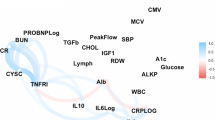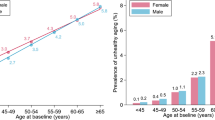Abstract
Chronological age alone is not a sufficient measure of the true physiological state of the body. The aims of the present study were to: (1) quantify biological age based on a physiological biomarker composite model; (2) and evaluate its association with death and age-related disease onset in the setting of an elderly population. Using structural equation modeling we computed biological age for 1699 individuals recruited from the first and second waves of the Rotterdam study. The algorithm included nine physiological parameters (c-reactive protein, creatinine, albumin, total cholesterol, cytomegalovirus optical density, urea nitrogen, alkaline phosphatase, forced expiratory volume and systolic blood pressure). We assessed the association between biological age, all-cause mortality, all-cause morbidity and specific age-related diseases over a median follow-up of 11 years. Biological age, compared to chronological age or the traditional biomarkers of age-related diseases, showed a stronger association with all-cause mortality (HR 1.15 vs. 1.13 and 1.10), all-cause morbidity (HR 1.06 vs. 1.05 and 1.03), stroke (HR 1.17 vs. 1.08 and 1.04), cancer (HR 1.07 vs. 1.04 and 1.02) and diabetes mellitus (HR 1.12 vs. 1.01 and 0.98). Individuals who were biologically younger exhibited a healthier life-style as reflected in their lower BMI (P < 0.001) and lower incidence of stroke (P < 0.001), cancer (P < 0.01) and diabetes mellitus (P = 0.02). Collectively, our findings suggest that biological age based on the biomarker composite model of nine physiological parameters is a useful construct to assess individuals 65 years and older at increased risk for specific age-related diseases.

Similar content being viewed by others
References
Hayflick L. The future of ageing. Nature. 2000;408(6809):267–9.
Sebastiani P, Thyagarajan B, Sun F, et al. Biomarker signatures of aging. Aging Cell. 2017;16(2):329–38.
Murray CJ, Atkinson C, Bhalla K, et al. The state of US health, 1990-2010: burden of diseases, injuries, and risk factors. JAMA. 2013;310(6):591–608. https://doi.org/10.1001/jama.2013.13805.
Burch JB, Augustine AD, Frieden LA, et al. Advances in geroscience: impact on healthspan and chronic disease. J Gerontol Ser A, Biol Sci Med Sci. 2014;69(Suppl 1):S1–3. https://doi.org/10.1093/gerona/glu041.
Comfort A. Test-battery to measure ageing-rate in man. Lancet. 1969;294(7635):1411–5.
Klemera P, Doubal S. A new approach to the concept and computation of biological age. Mech Ageing Dev. 2006;127(3):240–8.
Levine ME. Modeling the rate of senescence: can estimated biological age predict mortality more accurately than chronological age? J Gerontol Ser A: Biomed Sci Med Sci. 2012;68(6):667–74.
Ikram MA, Brusselle GGO, Murad SD, et al. The Rotterdam Study: 2018 update on objectives, design and main results. Eur J Epidemiol. 2017;32:807–50.
Centers for Disease Control and Prevention (CDC). National Center for Health Statistics (NCHS). National health and nutrition examination survey data. Hyattsville, MD: CDC. http://www.cdc.gov/nchs/nhanes/nh3data.htm. Accessed May 2018.
Levine ME. Response to Dr. Mitnitski’s and Dr. Rockwood’s letter to the editor: biological age revisited. J Gerontol Ser A: Biomed Sci Med Sci. 2013;69(3):297–8.
Belsky DW, Caspi A, Houts R, et al. Quantification of biological aging in young adults. Proc Natl Acad Sci USA. 2015;112(30):E4104–10. https://doi.org/10.1073/pnas.1506264112.
Yoo J, Kim Y, Cho ER, Jee SH. Biological age as a useful index to predict seventeen-year survival and mortality in Koreans. BMC Geriatr. 2017;17(1):7.
Kreisberg RA, Kasim S. Cholesterol metabolism and aging. Am J Med. 1987;82(1b):54–60.
Hollingsworth JW, Hashizume A, Jablon S. Correlations between tests of aging in Hiroshima subjects—an attempt to define “physiologic age”. Yale J Biol Med. 1965;38(1):11–26.
Takeda H, Inada H, Inoue M, Yoshikawa H, Abe H. Evaluation of biological age and physical age by multiple regression analysis. Med Inform = Medecine et informatique. 1982;7(3):221–7.
Kroll J, Saxtrup O. On the use of regression analysis for the estimation of human biological age. Biogerontology. 2000;1(4):363–8.
Bae CY, Kang YG, Kim S, et al. Development of models for predicting biological age (BA) with physical, biochemical, and hormonal parameters. Arch Gerontol Geriatr. 2008;47(2):253–65. https://doi.org/10.1016/j.archger.2007.08.009.
Hofecker G, Skalicky M, Kment A, Niedermuller H. Models of the biological age of the rat. I. A factor model of age parameters. Mech Ageing Dev. 1980;14(3–4):345–59.
Skalicky M, Hofecker G, Kment A, Niedermuller H. Models of the biological age of the rat. II. Multiple regression models in the study on influencing aging. Mech Ageing Dev. 1980;14(3–4):361–77.
Nakamura E, Miyao K, Ozeki T. Assessment of biological age by principal component analysis. Mech Ageing Dev. 1988;46(1–3):1–18.
Nakamura E, Miyao K. A method for identifying biomarkers of aging and constructing an index of biological age in humans. J Gerontol Ser A, Biol Sci Med Sci. 2007;62(10):1096–105.
MacDonald SW, Dixon RA, Cohen AL, Hazlitt JE. Biological age and 12-year cognitive change in older adults: findings from the Victoria longitudinal study. Gerontology. 2004;50(2):64–81. https://doi.org/10.1159/000075557.
Barzilai N, Guarente L, Kirkwood TB, Partridge L, Rando TA, Slagboom PE. The place of genetics in ageing research. Nat Rev Genet. 2012;13(8):589–94. https://doi.org/10.1038/nrg3290.
Heyn H, Li N, Ferreira HJ, et al. Distinct DNA methylomes of newborns and centenarians. Proc Natl Acad Sci USA. 2012;109(26):10522–7. https://doi.org/10.1073/pnas.1120658109.
Barker DJ, Eriksson JG, Forsen T, Osmond C. Fetal origins of adult disease: strength of effects and biological basis. Int J Epidemiol. 2002;31(6):1235–9.
Belsky DW, Moffitt TE, Cohen AA, et al. Eleven telomere, epigenetic clock, and biomarker-composite quantifications of biological aging: do they measure the same thing? Am J Epidemiol. 2017;187(6):1220–30.
Crimmins E, Vasunilashorn S, Kim JK, Alley D. Biomarkers related to aging in human populations. Adv Clin Chem. 2008;46:161–216.
Longo VD, Antebi A, Bartke A, et al. Interventions to slow aging in humans: are we ready? Aging Cell. 2015;14(4):497–510. https://doi.org/10.1111/acel.12338.
de Cabo R, Carmona-Gutierrez D, Bernier M, Hall MN, Madeo F. The search for antiaging interventions: from elixirs to fasting regimens. Cell. 2014;157(7):1515–26. https://doi.org/10.1016/j.cell.2014.05.031.
Moffitt TE, Belsky DW, Danese A, Poulton R, Caspi A. The longitudinal study of aging in human young adults: knowledge gaps and research agenda. J Gerontol Ser A, Biol Sci Med Sci. 2017;72(2):210–5. https://doi.org/10.1093/gerona/glw191.
Kirkland JL. Translating advances from the basic biology of aging into clinical application. Exp Gerontol. 2013;48(1):1–5. https://doi.org/10.1016/j.exger.2012.11.014.
Kirkwood TB, Austad SN. Why do we age? Nature. 2000;408(6809):233–8.
Acknowledgements
The dedication and commitment by which study participants, general practitioners, and pharmacists of the Ommoord district contribute to the Rotterdam Study are gratefully acknowledged. We thank all staff at the Rotterdam Study research center, facilitating assessment of participants throughout the years, and Frank J.A. van Rooij as data manager.
Funding
The Rotterdam Study is sponsored by the Erasmus Medical Centre and Erasmus University Rotterdam, The Netherlands Organization for Scientific Research (NWO), The Netherlands Organization for Health Research and Development (ZonMW), the Research Institute for Diseases in the Elderly (RIDE), The Netherlands Genomics Initiative, the Ministry of Education, Culture and Science, the Ministry of Health, Welfare and Sports, the European Commission (DG XII), and the Municipality of Rotterdam. Further support was obtained from the Netherlands Consortium for Healthy Ageing. This study is supported by Janssen Prevention Centre.
Author information
Authors and Affiliations
Corresponding author
Additional information
Publisher's Note
Springer Nature remains neutral with regard to jurisdictional claims in published maps and institutional affiliations.
Electronic supplementary material
Below is the link to the electronic supplementary material.
Rights and permissions
About this article
Cite this article
Waziry, R., Gras, L., Sedaghat, S. et al. Quantification of biological age as a determinant of age-related diseases in the Rotterdam Study: a structural equation modeling approach. Eur J Epidemiol 34, 793–799 (2019). https://doi.org/10.1007/s10654-019-00497-3
Received:
Accepted:
Published:
Issue Date:
DOI: https://doi.org/10.1007/s10654-019-00497-3




